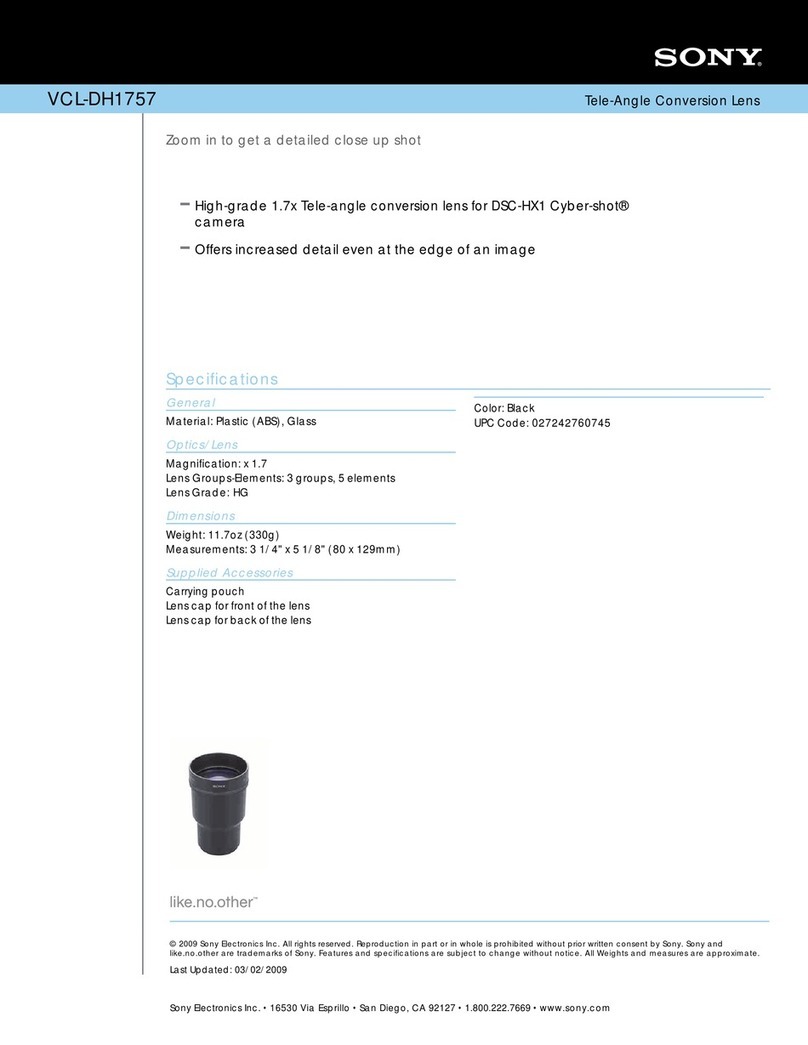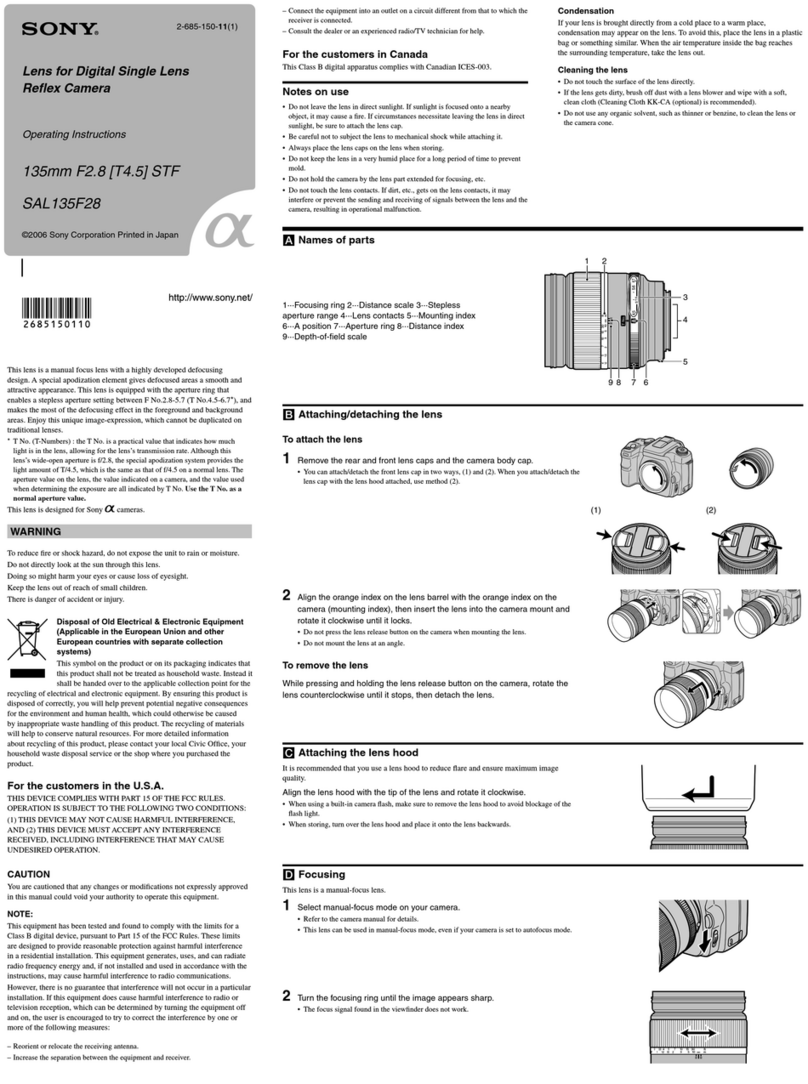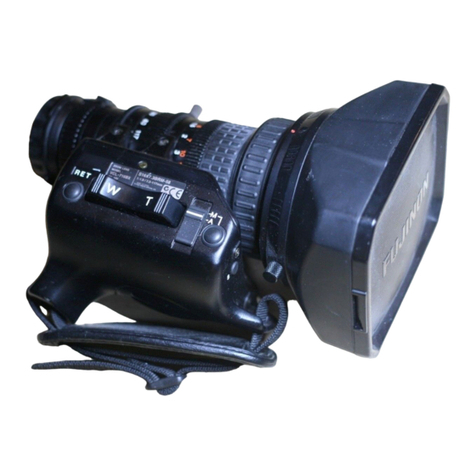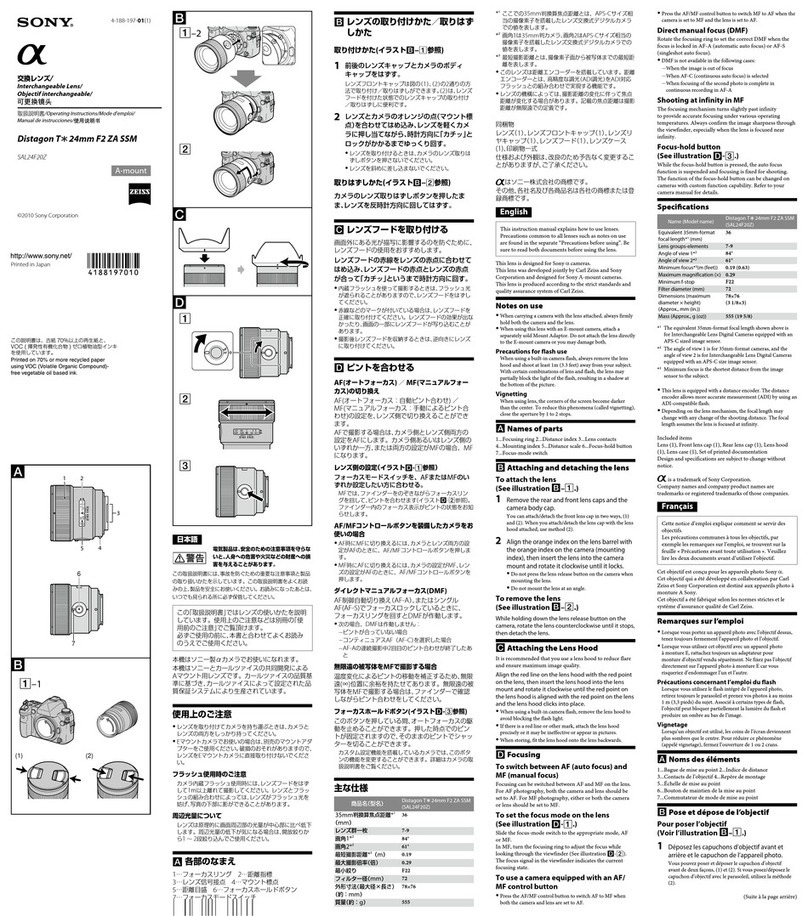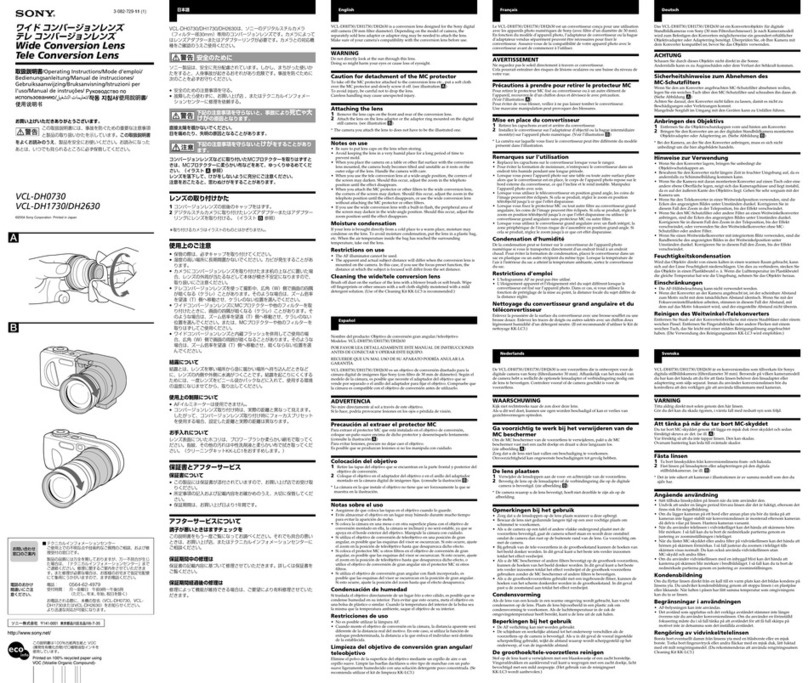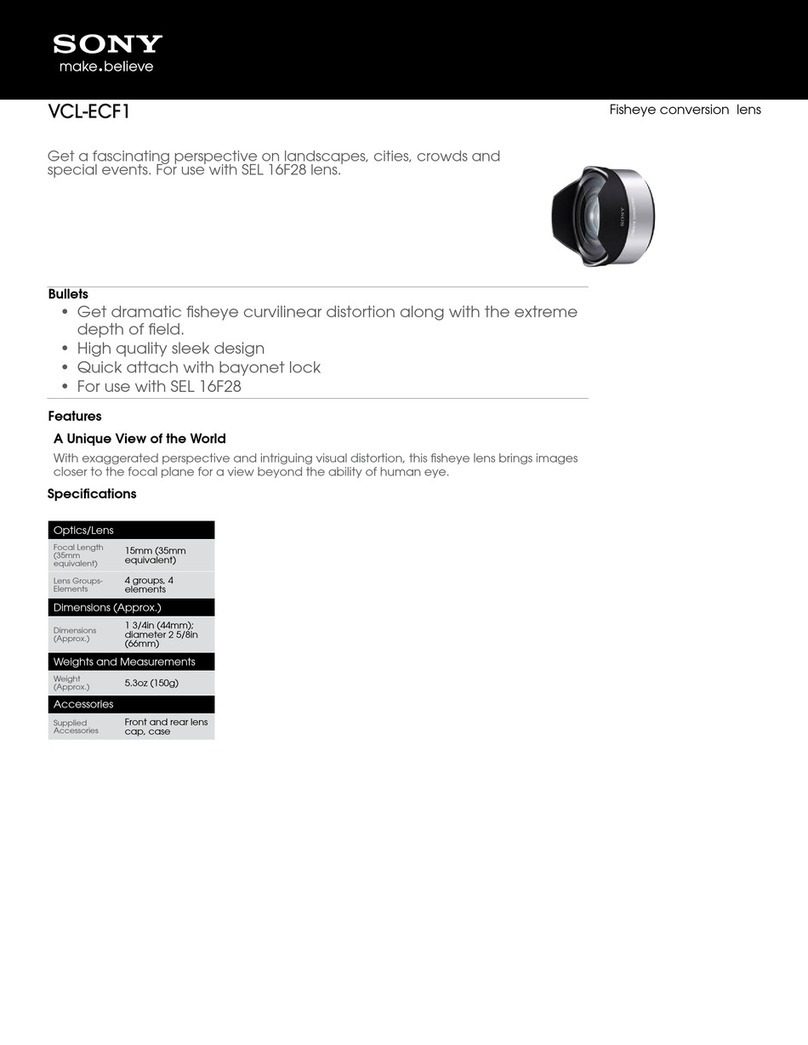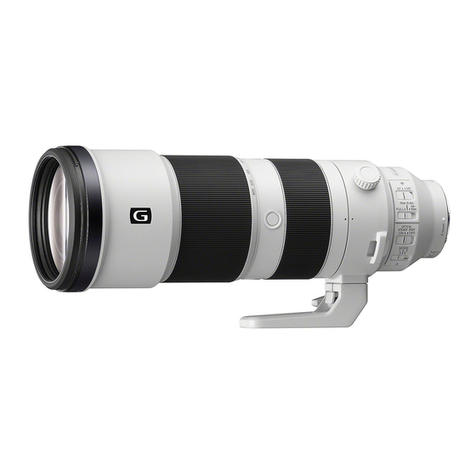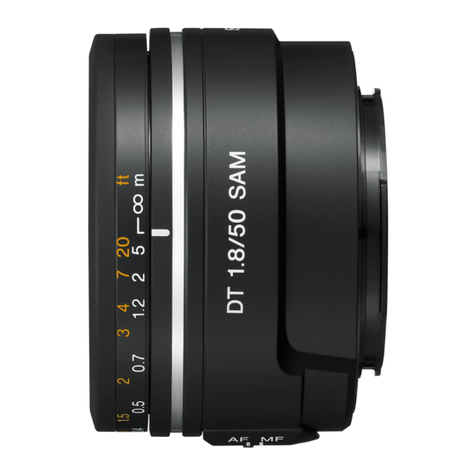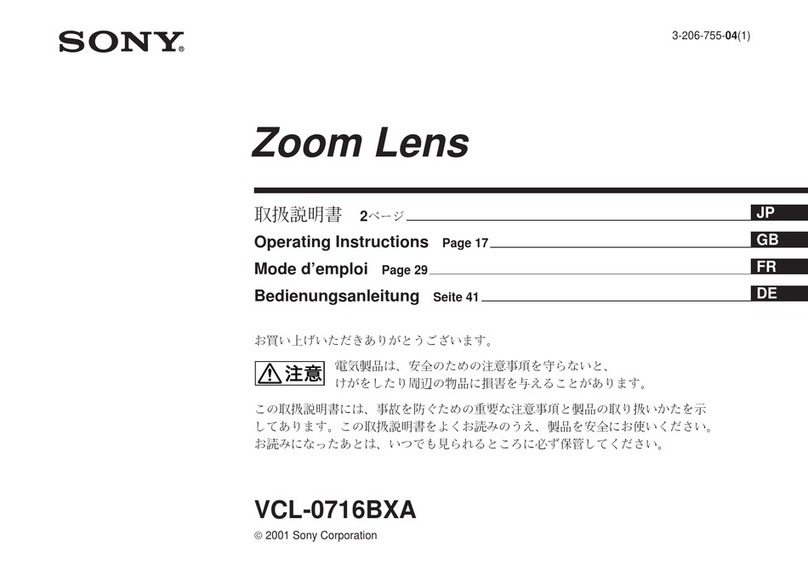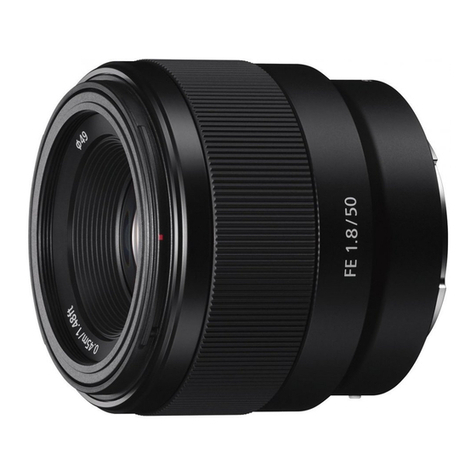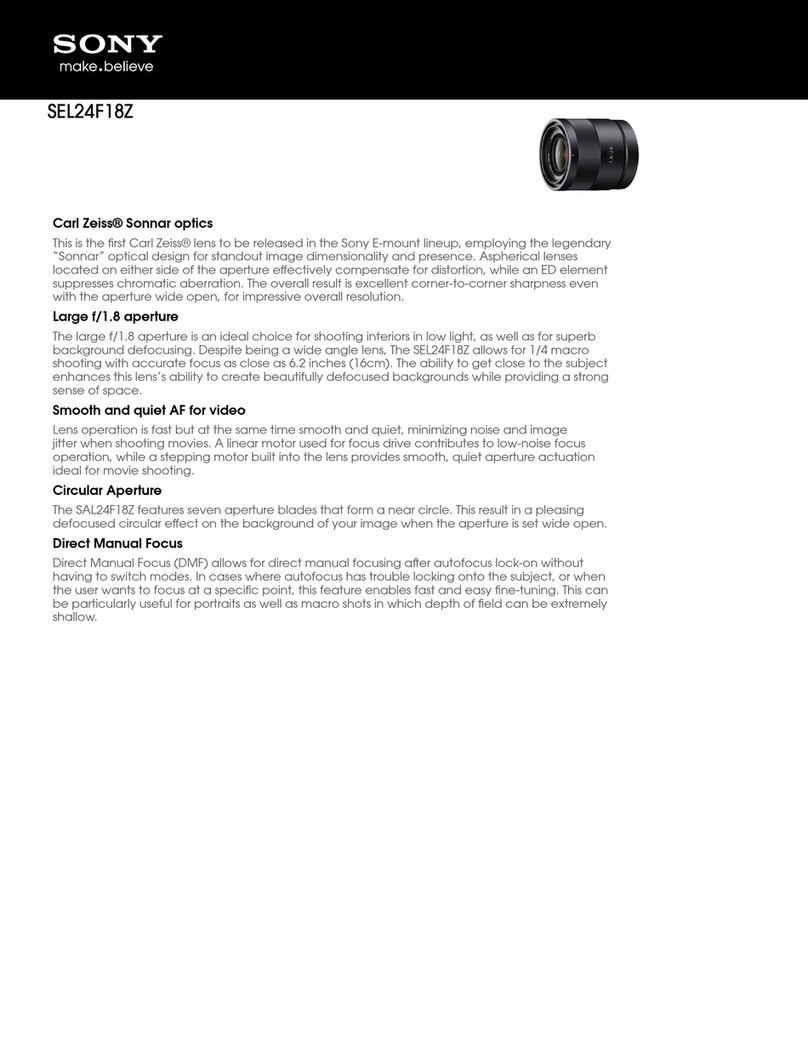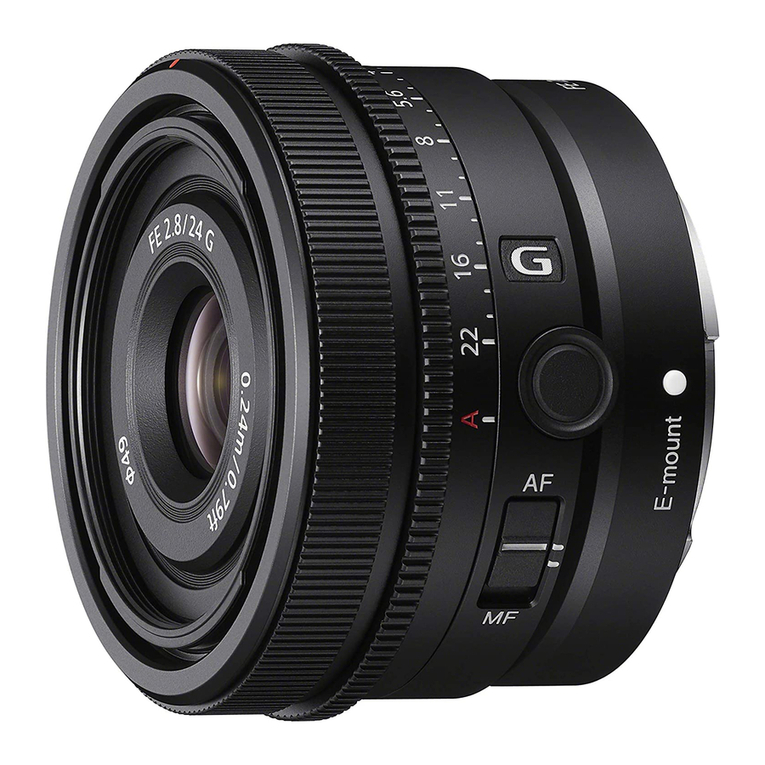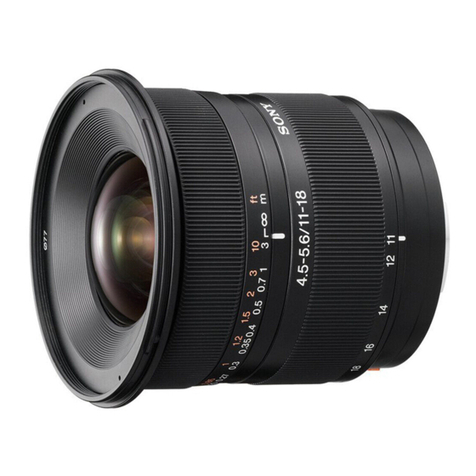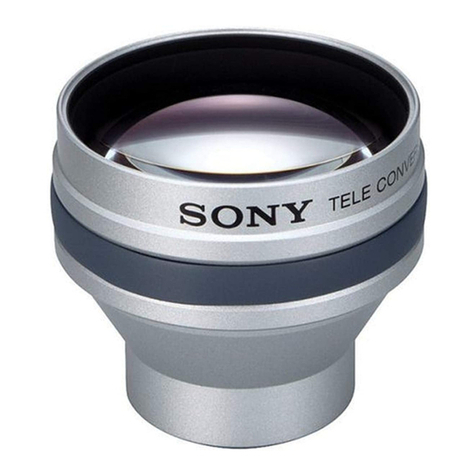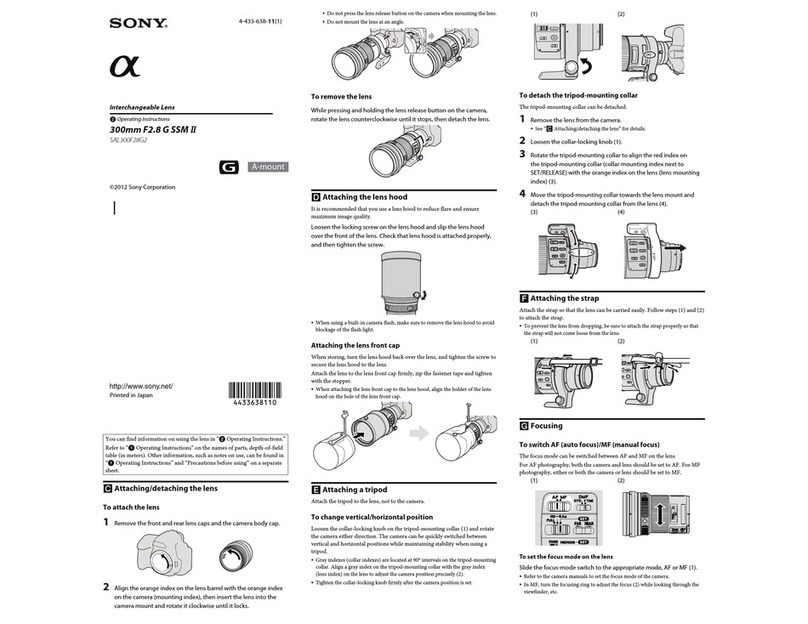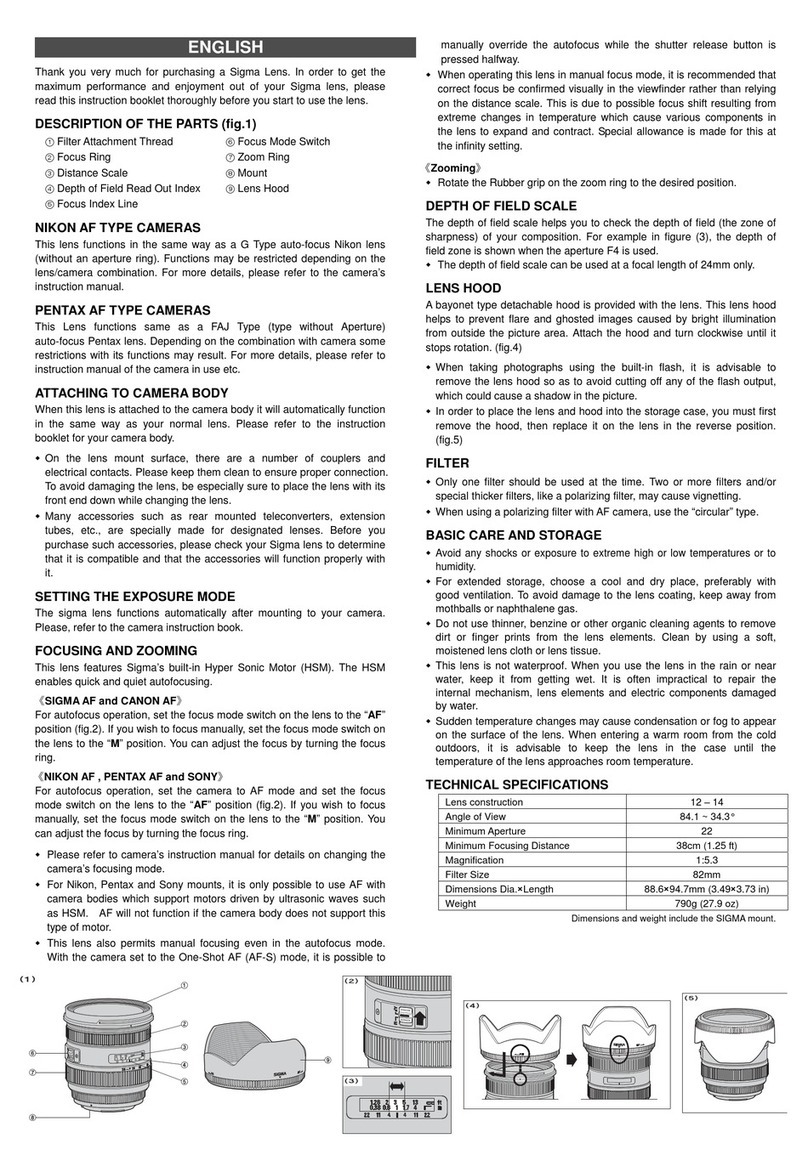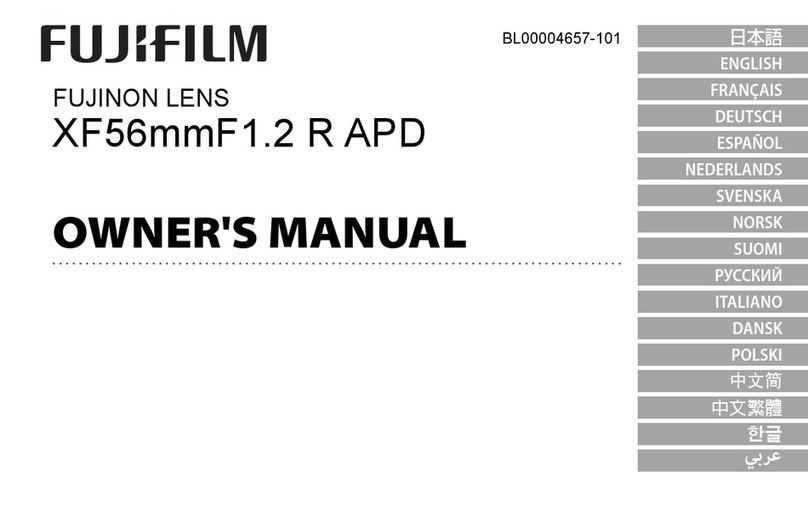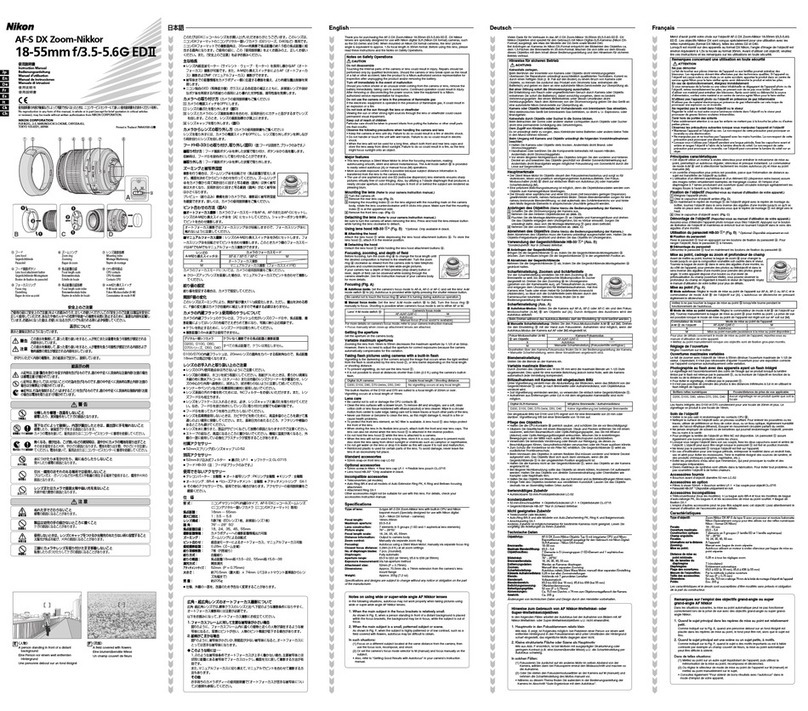
–1
(1) (2)
電気製品は、安全のための注意事項を守
らないと、人身への危害や火災などの財
産への損害を与えることがあります。
この取扱説明書には、事故を防ぐための重要な注意事項と
製品の取り扱いかたを示しています。この取扱説明書を
よくお読みの上、製品を安全にお使いください。お読みに
なったあとは、いつでも見られる所に必ず保管してくださ
い。
この「取扱説明書」ではレンズの使いかたを説明
しています。使用上のご注意などは別冊の「使
用前のご注意」でご覧頂けます。
必ずご使用の前に、本書と合わせてよくお読み
のうえでご使用ください。
本機はソニー製αカメラシステムEマウントカメラ
専用のレンズです。Aマウントカメラにはお使いに
なれません。
(カメラ本体との互換情報については)専用サポー
トサイトでご確認ください。
http://www.sony.co.jp/DSLR/support/
使用上のご注意
レンズを取り付けてカメラを持ち運ぶときは、カメラと
レンズの両方をしっかり持ってください。
本機は防じん、防滴性に配慮して設計されていますが、防
水性能は備えていません。雨中使用時などは、水滴がか
からないようにしてください。
フラッシュ使用時のご注意
カメラ内蔵フラッシュはお使いになれません。外付けフ
ラッシュ(別売)をご使用ください。
周辺光量について
レンズは原理的に画面周辺部の光量が中心部に比べ低下
します。周辺光量の低下が気になる場合は、開放絞りか
ら1〜 2段絞り込んでご使用ください。
各部のなまえ
1 レンズフード指標 2 フォーカスリング
3 ズームリング 4 焦点距離指標(グレー)
5 三脚座指標(グレー)
6 レンズ信号接点*
7 三脚座 8 フォーカスホールドボタン
9 焦点距離目盛 10 フォーカスモードスイッチ
11 フォーカスレンジ切り替えスイッチ
12 三脚座標点(グレー)
13 マウント標点
14 三脚座クランプノブ
15 手ブレ補正モードスイッチ
16 手ブレ補正スイッチ
* 直接手で触れないでください。
レンズの取り付けかた/取りはず
しかた
取り付けかた(イラスト–参照)
1
レンズの前後レンズキャップとカメラのボ
ディキャップをはずす。
レンズフロントキャップは図の(1)、(2)の2通りの
方法で取り付け/取りはずしができます。(2)は、レ
ンズフードを付けた状態でのレンズキャップの取り
付け/取りはずしに便利です。
2
レンズとカメラの白の点(マウント標点)を
合わせてはめ込み、レンズを軽くカメラに押
し当てながら、時計方向に「カチッ」とロック
がかかるまでゆっくり回す。
レンズを取り付けるときは、カメラのレンズ取りは
ずしボタンを押さないでください。
レンズを斜めに差し込まないでください。
取りはずしかた(イラスト–参照)
カメラのレンズ取りはずしボタンを押したま
ま、レンズを反時計方向に回してはずす。
三脚を使う
三脚をお使いの場合、カメラの三脚ネジ穴ではな
く、レンズの三脚座に取り付けます。
縦位置・横位置の変更
三脚座クランプノブをゆるめると(1)、カメラごと
任意に回転させることができます。三脚使用時に、
安定感を損なわずに縦位置/横位置の変更をすば
やくできます。
三脚座には、90°ごとにグレーの点(三脚座標点)があ
ります。レンズ側のグレーの線(三脚座指標)と合わせる
と、カメラの正確な位置決めができます(2)。
位置を決めた後は、三脚座クランプノブをしっかりと締
めてください。
三脚座を回転すると一部のカメラ本体、およびアクセサ
リと干渉します。カメラ本体、およびアクセサリとの互換
情報については専用サポートサイトでご確認ください。
三脚座の取りはずしかた
三脚をお使いにならない場合、レンズから三脚座を
取りはずすことができます。
1
レンズをカメラから取りはずす。
詳しくは、「
レンズの取り付けかた/取りはずし
かた」を参照してください。
2
三脚座クランプノブを回し、三脚座取りは
ずし指標とクランプノブの標点を合わせる
(3)。
3
三脚座クランプノブを引っ張りながら下げ
(4)、三脚座を開く。
三脚座を開くときはレンズと三脚座の両方をしっか
り持ってください。
–2
(1) (2)
(3) (4)
(1) (2)
4-531-386-03(1)
©2014 Sony Corporation
SEL70200G
交換レンズ
Interchangeable Lens
Objectif interchangeable
取扱説明書
Operating Instructions
Mode d’emploi
Manual de instrucciones
E-mount
Printed in Japan
FE 70-200mm F4 G OSS
1 6
13
14
3 4 52
9 11 1210
8 7
16 15
三脚座のヒンジ部を持って開くと、手を挟むおそれ
があります。三脚座を開くときはヒンジ部以外を
持ってください。
レンズをカメラから取りはずさずに三脚座を開く
と、一部のカメラ本体およびアクセサリと干渉しま
す。三脚座を取りはずす際は、レンズをカメラから
取りはずすことをおすすめします。
レンズフードを取り付ける
画面外にある光が描写に影響するのを防ぐために、
レンズフードの使用をおすすめします。
レンズフードの赤線をレンズの赤線(レンズ
フード指標)に合わせてはめ込み、レンズフード
の赤点とレンズの赤線が合って「カチッ」という
まで時計方向に回す。
外付けフラッシュ(別売)を使って撮影するときは、フ
ラッシュ光が遮られることがありますので、レンズフー
ドをはずしてください。
撮影後レンズフードを収納するときは、逆向きにレンズ
に取り付けてください。
ズームする
ズームリングを回して、希望の焦点距離(ズームの
位置)に合わせる。
ピントを合わせる
本製品のフォーカスモードスイッチは、一部のカメラ本
体においてお使いになれません。
カメラ本体との互換情報については専用サポートサイト
でご確認ください。
AF(オートフォーカス)/ MF(マニュア
ルフォーカス)の切り替え
AF
(オートフォーカス:自動ピント合わせ)/ MF
(マ
ニュアルフォーカス:手動によるピント合わせ)の
設定を、レンズ側で切り替えることができます。
AFで撮影する場合は、カメラ側とレンズ側両方の
設定をAFにします。カメラ側あるいはレンズ側の
いずれか一方、または両方の設定がMFの場合、MF
になります。
レンズ側の設定
フォーカスモードスイッチを、AFまたはMFの
いずれか設定したいほうに合わせる(1)。
カメラのフォーカスモードの設定方法については、カメ
ラの取扱説明書をご覧ください。
MFではファインダー等を見ながらフォーカスリングを
回して、ピントを合わせます(2)。
AF/MFコントロールボタンを装備したカメラをお
使いの場合
AF時にMFに切り替えるには、カメラとレンズ両方の設
定がAFのときに、AF/MFコントロールボタンを押しま
す。
MF時にAFに切り替えるには、カメラの設定がMF、レン
ズの設定がAFのときに、AF/MFコントロールボタンを
押します。
手ブレ補正を使用する
手ブレ補正スイッチ
ON:
手ブレを補正します。
OFF:
手ブレを補正しません。撮影時、三脚をお使いに
なることをおすすめします。
手ブレ補正モードスイッチ
手ブレ補正スイッチをONにし、手ブレ補正モード
切り換えスイッチを設定します。
MODE1:
主に、通常の手ブレを補正します。(ノーマル)
MODE2:
移動する被写体を流し撮りする場合、手ブレ
を補正します。
フォーカスホールドボタンを使用
する
本製品のフォーカスホールドボタンは、一部のカメラ本
体においてお使いになれません。
カメラ本体との互換情報については専用サポートサイト
でご確認ください。
フォーカスホールドボタンが3箇所に配置されてい
ます。
AF中にフォーカスホールドボタンを押すと、AFの
駆動を止めることができます。ピントが固定され、
そのままのピントでシャッターを切れます。シャッ
ターボタンを半押しした状態で、フォーカスホール
ドボタンを離すと、AFが再開します。
フォーカスレンジ(AF駆動範囲)
を切り替える
AFの駆動範囲を切り替えて、ピント合わせの時間
を短縮できます。撮影距離が一定の範囲内に限ら
れている場合に便利です。
フォーカスレンジ切り替えスイッチで、撮影距
離範囲を選択する。
FULL : 距離制限はありません。全域でAFが駆動します。
∞-3m : 無限遠から3.0mまでAFが駆動します。
Tighten the collar-locking knob firmly after the camera
position is set.
The collar may hit the camera body or accessory when rotated,
depending on the camera or accessory model. For more
information on compatibility with cameras and accessories,
visit the Sony web site for your area.
To detach the tripod-mounting collar
from the lens
The tripod-mounting collar can be detached from the lens
when not using a tripod.
1
Remove the lens from the camera.
See “ Attaching/detaching the lens” for details.
2
Turn the collar-locking knob, to align the
marks of collar-locking knob and the collar
(3).
3
Pull the collar-locking knob down (4), and
open the collar.
Hold the lens and the collar firmly when opening the
collar.
Do not hold the hinge when opening the collar. If you
hold the hinge you may pinch your hand.
If you open the collar without removing the lens from the
camera, the collar may hit the camera body or accessory.
We recommend you remove the lens from the camera
before detaching the collar.
Attaching the lens hood
It is recommended that you use a lens hood to reduce flare
and ensure maximum image quality.
Align the red line on the lens hood with the red line
on the lens (lens hood index), then insert the lens
hood into the lens mount and rotate it clockwise until
it clicks into place and the red dot on the lens hood is
aligned with the red line on the lens (lens hood index).
When using an external flash (sold separately), remove the
lens hood to avoid blocking the flash light.
When storing, fit the lens hood onto the lens backwards.
Zooming
Rotate the zooming ring to the desired focal length.
Focusing
The focus-mode switch of this lens does not function with
some camera models.
For further information on compatibility, visit the Sony
web site in your area, or consult your Sony dealer or local
authorized Sony service facility.
To switch AF (auto focus)/MF (manual
focus)
The focus mode can be switched between AF and MF on
the lens.
For AF photography, both the camera and lens should be
set to AF. For MF photography, either or both the camera or
lens should be set to MF.
To set the focus mode on the lens
Slide the focus-mode switch to the appropriate mode, AF
or MF (1).
Refer to the camera manuals to set the focus mode of the
camera.
In MF, turn the focusing ring to adjust the focus (2) while
looking through the viewfinder, etc.
To use a camera equipped with an AF/MF
control button
Press the AF/MF control button to switch AF to MF when
both the camera and lens are set to AF.
Press the AF/MF control button to switch MF to AF when the
camera is set to MF and the lens is set to AF.
Using the shake compensation
function
Shake compensation switch
ON: Compensate for camera shake.
OFF: Does not compensate for camera shake. We recommend
using a tripod during shooting.
Shake compensation mode switch
Set the shake compensation switch to ON, and set the shake
compensation mode switch.
MODE1: Compensate for normal camera shake.
MODE2: Compensate for camera shake when panning
moving sublects.
Using focus-hold buttons
The focus-hold button of this lens does not function with
some camera models.
For further information on compatibility, visit the Sony
web site in your area, or consult your Sony dealer or local
authorized Sony service facility.
This lens has 3 focus-hold buttons.
Press the focus-hold button in AF to cancel AF. The focus
is fixed and you can release the shutter on the fixed focus.
Release the focus-hold button while pressing the shutter
button halfway to start AF again.
Switching focus range (AF range)
The focus-range limiter enables you to reduce the auto
focusing time. This is useful when the subject distance is
definite.
Slide the focus-range limiter to select the focus range.
FULL: AF is set to the minimum focusing distance to infinity.
∞ - 3m: AF is set to 3 m (9.8 feet) to infinity.
主な仕様
商品名(型名) FE 70-200mm F4 G OSS
(SEL70200G)
35mm判換算焦点距離*1
(mm)105-300
レンズ群一枚 15-21
画角1*234°-12°
画角2*222°-8°
最短撮影距離*3
(m)
オートフォーカス時
マニュアルフォーカス時
1.0-1.5
1.0-1.35
最大撮影倍率(倍) 0.13
最小絞り F22
フィルター径(mm)72
外形寸法(最大径×長さ)
(約:mm)
80×175
質量(約:g)(三脚座別) 840
手ブレ補正機能 あり
*1ここでの35mm判換算焦点距離とは、APS-Cサイズ相
当の撮像素子を搭載したレンズ交換式デジタルカメラ
での値を表します。
*2画角1は35mm判カメラ、画角2はAPS-Cサイズ相当の
撮像素子を搭載したレンズ交換式デジタルカメラでの
値を表します。
*3最短撮影距離とは、撮像素子面から被写体までの距離を
表します。
レンズの機構によっては、撮影距離の変化に伴って焦点
距離が変化する場合があります。記載の焦点距離は撮影
距離が無限遠での定義です。
同梱物:レンズ(1)、レンズフロントキャップ(1)、
レンズリヤキャップ(1)、レンズフード(1)、レンズ
ケース(1)、印刷物一式
仕様および外観は、改良のため予告なく変更するこ
とがありますが、ご了承ください。
および はソニー株式会社の商標です。
This instruction manual explains how to use lenses.
Notes on use are found in the separate “Precautions
before using”. Be sure to read both documents before
using your lens.
This lens is designed for Sony α camera system E-mount
cameras. You cannot use it on A-mount cameras.
For further information on compatibility, visit the Sony
web site in your area, or consult your Sony dealer or local
authorized Sony service facility.
Notes on use
When carrying a camera with the lens attached, always firmly
hold both the camera and the lens.
This lens is not water-proof, although designed with dust-
proofness and splash-proofness in mind. If using in the rain
etc., keep water drops away from the lens.
Precautions on using a flash
You cannot use a built-in camera flash with this lens. Use an
external flash (sold separately).
Vignetting
When using the lens, the corners of the screen become darker
than the center. To reduce this phenomena (called vignetting),
close the aperture by 1 to 2 stops.
Identifying the parts
1 Lens hood index 2 Focusing ring 3 Zooming ring
4 Focal-length index (gray) 5 Collar index (gray)
6 Lens contacts*7 Tripod-mounting collar
8 Focus-hold button 9 Focal-length scale
10 Focus-mode switch 11 Focus-range limiter
12 Collar index (gray) 13 Lens mounting index
14 Collar-locking knob
15 Shake compensation mode switch
16 Shake compensation switch
*Do not touch the lens contacts.
Attaching/detaching the lens
To attach the lens (See illustration
–.)
1
Remove the rear and front lens caps and the
camera body cap.
You can attach/detach the front lens cap in two ways, (1)
and (2). When you attach/detach the lens cap with the
lens hood attached, use method (2).
2
Align the white dot on the lens barrel with
the white dot on the camera (mounting
index), then insert the lens into the camera
mount and rotate it clockwise until it locks.
Do not press the lens release button on the camera when
mounting the lens.
Do not mount the lens at an angle.
To remove the lens (See illustration
–.)
While holding down the lens release button on the
camera, rotate the lens counterclockwise until it stops,
then detach the lens.
Using the tripod
When using a tripod, attach it to the-mounting collar of the
lens, not to the tripod receptacle of the camera.
To change vertical/horizontal position
Loosen the collar-locking knob on the tripod-mounting collar
(1) and rotate the camera either direction. The camera can be
quickly switched between vertical and horizontal positions
while maintaining stability when using a tripod.
Gray dots (collar indexes) are located at 90° intervals on the
collar. Align a gray dot on the tripod-mounting collar with
the gray line (collar index) on the lens to adjust the camera
position precisely (2).
Specifications
Name (Model name) FE 70-200mm F4 G OSS
(SEL70200G)
Equivalent 35mm-format focal
length*1(mm)
105-300
Lens groups-elements 15-21
Angle of view 1*234°-12°
Angle of view 2*222°-8°
Minimum focus*3(m (feet))
Auto focus
Manual focus
1.0-1.5 (3.28-4.93)
1.0-1.35 (3.28-4.43)
Maximum magnification (×) 0.13
Minimum aperture f/22
Filter diameter (mm) 72
Dimensions
(maximum diameter × height)
(approx., mm (in.))
80 × 175
(3 1/4 × 7)
Mass (approx., g (oz.))
(excluding tripod-mounting collar)
840 (29.7)
Shake compensation function Yes
*1The values shown above for equivalent 35mm-format
focal length are for Interchangeable Lens Digital Cameras
equipped with an APS-C sized image sensor.
*2Angle of view 1 is the value for 35mm cameras, and angle of
view 2 is the value for Interchangeable Lens Digital Cameras
equipped with an APS-C sized image sensor.
*3Minimum focus is the distance from the image sensor to the
subject.
Depending on the lens mechanism, the focal length may
change with any change in shooting distance. The focal lengths
given above assume the lens is focused at infinity.
Included items: Lens (1), Front lens cap (1), Rear lens cap
(1), Lens hood (1), Lens case (1), Set of printed
documentation
Designs and specifications are subject to change without
notice.
and is a trademark of Sony Corporation.
Cette notice explique comment se servir des objectifs.
Les remarques sur l’emploi se trouvent dans les
« Précautions avant toute utilisation » séparées. Veuillez
lire les deux documents avant d’utiliser votre objectif.
Votre objectif est conçu pour les appareils photo à monture
E de type Sony α. Il ne peut pas être utilisé pour les appareils
photo à monture A.
Pour plus d’informations sur la compatibilité, consultez le
site de Sony de votre pays, ou adressez-vous à un revendeur
Sony ou à un service après-vente agréé Sony.
Remarques sur l’utilisation
Lorsque vous portez un appareil photo avec l’objectif dessus,
tenez toujours fermement l’appareil photo et l’objectif.
Cet objectif n’est pas étanche à l’eau bien qu’il soit conçu pour
résister à la poussière et aux éclaboussures. Si vous l’utilisez
sous la pluie, etc. veillez à ce que de l’eau ne tombe pas dessus.
Précautions concernant l’emploi d’un flash
Vous ne pouvez pas utiliser le flash de l’appareil photo avec cet
objectif. Utilisez un flash externe (vendu séparément).
Vignetage
Lorsque l’objectif est utilisé, les coins de l’écran deviennent plus
sombres que le centre. Pour réduire ce phénomène (appelé
vignetage), fermez l’ouverture de 1 ou 2 crans.
Identification des éléments
1 Repère de parasoleil 2 Bague de mise au point
3 Bague du zoom 4 Repère de la longueur focale (gris)
5 Repère du cadre (gris) 6 Contacts de l’objectif*
7 Cadre de montage du trépied
8 Touche de désactivation de la mise au point
9 Echelle de la longueur focale
10 Commutateur de mise au point
11 Limiteur de plage de mise au point
12 Repère du cadre (gris)
13 Repère de montage de l’objectif
14 Bouton de verrouillage du cadre
15 Commutateur du mode Antibougé
16 Commutateur Antibougé
*Ne touchez pas les contacts d’objectif.
Fixation/retrait de l’objectif
Fixation de l’objectif (Voir l’illustration
–.)
1
Retirez les capuchons d’objectif situés à
l’avant et l’arrière, ainsi que le capuchon de
l’appareil photo.
Vous pouvez poser et déposer les capuchons d’objectif
avant de deux façons, (1) et (2). Si vous posez/déposez le
capuchon d’objectif avec le parasoleil, utilisez la méthode
(2).
2
Alignez le point blanc du barillet d’objectif
sur le point blanc de l’appareil photo (repère
de montage), puis posez l’objectif sur la
monture de l’appareil photo et tournez-le
dans le sens horaire de sorte qu’il
s’encliquette.
N’appuyez pas sur la touche de déblocage de l’objectif de
l’appareil photo lorsque vous fixez l’objectif.
Ne fixez pas l’objectif de travers.
Retrait de l’objectif (Voir l’illustration
–.)
Tout en appuyant sur le bouton de libération de l’objectif
sur l’appareil photo, tournez l’objectif dans le sens
antihoraire jusqu’à l’arrêt, puis déposez l’objectif.
(Suite à la page arrière)
Utilisation du trépied
Lors de l’utilisation d’un trépied, fixez-le sur le cadre de
montage de l’objectif et non pas sur le logement du trépied
de l’appareil photo.
Modification de la position verticale/
horizontale
Desserrez la touche de verrouillage du cadre sur le cadre de
montage du trépied (1) puis orientez l’appareil photo dans
le sens de votre choix. Lorsque vous utilisez un trépied,
vous pouvez rapidement passer d’une position à l’autre tout
maintenant la stabilité de l’appareil photo.
Des points gris (repères de cadre) se trouvent à des intervalles
de 90° sur le cadre. Alignez un point gris du cadre sur la
ligne grise (repère de cadre) de l’objectif pour ajuster plus
précisément la position de l’appareil photo (2).
Après avoir réglé l’orientation de l’appareil photo, serrez
fermement le bouton de verrouillage du cadre.
Le cadre risque de heurter l’appareil photo ou l’accessoire lors
de la rotation, selon le modèle de caméra ou d’accessoire. Pour
plus d’informations sur la compatibilité avec les appareils
photo et accessoires, visitez le site Web de Sony de votre
région.
Détachement du cadre de montage du
trépied de l’objectif
Lors de l’utilisation d’un trépied, il est possible de détacher le
cadre de montage du trépied.
1
Retirez l’objectif de l’appareil photo.
Pour plus d’informations, reportez-vous à la section «
Fixation/retrait de l’objectif ».
2
Tournez le bouton de verrouillage du cadre
pour aligner les repères du bouton de
verrouillage du cadre sur le cadre (3).
3
Tirez le bouton de verrouillage du cadre le
bas (4), puis ouvrez le cadre.
Tenez l’objectif et le cadre fermement lors de l’ouverture
du cadre.
Ne tenez pas la charnière lors de l’ouverture du cadre.
Vous risqueriez de vous pincer la main dans le cas
contraire.
Si vous ouvrez le cadre sans retirer l’objectif de l’appareil
photo, le cadre risque de heurter l’appareil photo ou
l’accessoire. Nous vous conseillons de retirer l’objectif de
l’appareil photo avant de retirer le cadre.
Fixation du parasoleil
Il est conseillé d’utiliser un parasoleil pour réduire la lumière
parasite et obtenir la meilleure image possible.
Alignez la ligne rouge du parasoleil sur la ligne rouge
de l’objectif (repère de parasoleil), puis insérez le
parasoleil sur la monture d’objectif et tournez-le dans
le sens horaire jusqu’à ce qu’il s’encliquette et le point
rouge du parasoleil s’aligne sur la ligne rouge de
l’objectif (repère de parasoleil).
Si vous utilisez un flash externe (vendu séparément), retirez le
parasoleil pour éviter de bloquer la lumière du flash.
Pour ranger le parasoleil, insérez-le à l’arrière de l’objectif.
Utilisation du zoom
Tournez la bague du zoom pour obtenir la longueur
focale de votre choix.
Mise au point
Le commutateur du mode de mise au point de cet objectif ne
fonctionne pas sur certains modèles d'appareil photo.
Pour plus d’informations sur la compatibilité, consultez
le site de Sony de votre pays, ou adressez-vous à un
revendeur Sony ou à un service après-vente agréé Sony.
Commutation AF (mise au point
automatique) et MF (mise au point
manuelle)
Il est possible de régler le mode de mise au point sur AF ou
MF sur l’objectif.
Pour effectuer des prises de vue en mode AF, l’appareil
photo et l’objectif doivent tous deux être réglés sur AF. Pour
effectuer des prises de vue en mode MF, l’appareil photo ou
l’objectif doit être réglé sur MF.
Réglage du mode de mise au point sur l’objectif
Réglez le commutateur du mode de mise au point sur
le mode adapté, AF ou MF (1).
Reportez-vous aux manuels de l’appareil photo pour régler le
mode de mise au point de l’appareil photo.
En mode MF, tournez la bague de mise au point pour régler la
mise au point (2) tout en regardant dans le viseur, etc.
Utilisation d’un appareil photo doté de la
touche de commande AF/MF
Appuyez sur la touche de commande AF/MF pour passer de
AF à MF lorsque l’appareil photo et l’objectif sont réglés sur AF.
Appuyez sur la touche de commande AF/MF pour passer de
MF à AF lorsque l’appareil photo est réglé sur MF et l’objectif
sur AF.
Utilisation de la fonction Antibougé
Commutateur Antibougé
ON : compense les vibrations de l'appareil photo.
OFF : ne compense pas les vibrations de l'appareil photo. Nous
vous conseillons d'utiliser un trépied pendant la prise de
vue.
Commutateur du mode Antibougé
Réglez le commutateur Antibougé sur ON, puis réglez le
commutateur du mode Antibougé.
MODE1 : compense les vibrations normales de l'appareil
photo.
MODE2 : compense les vibrations de l'appareil photo lors d'un
panorama de sujets en mouvement.
